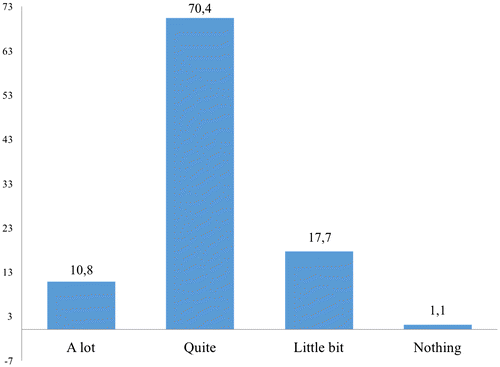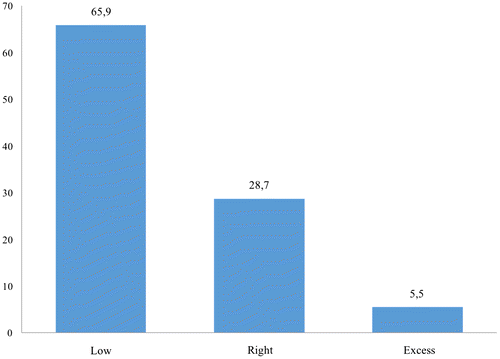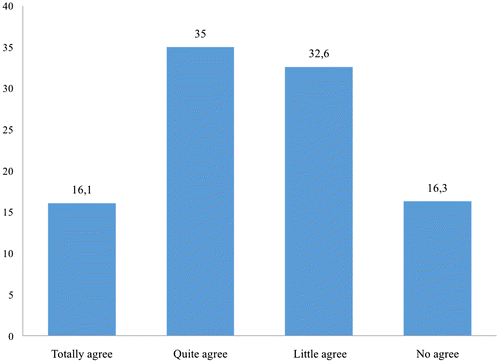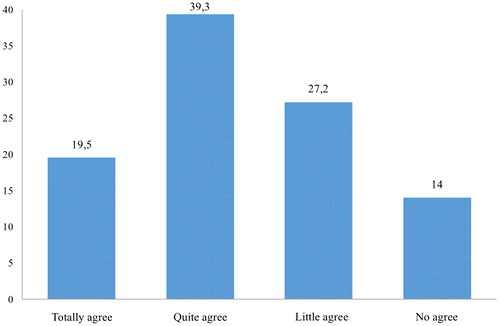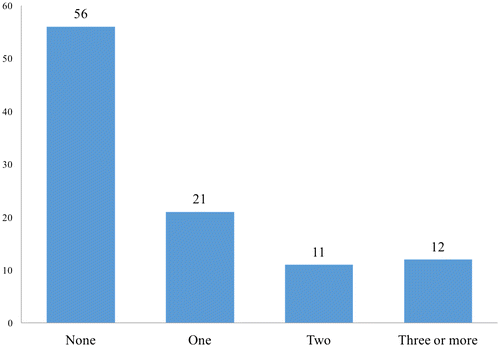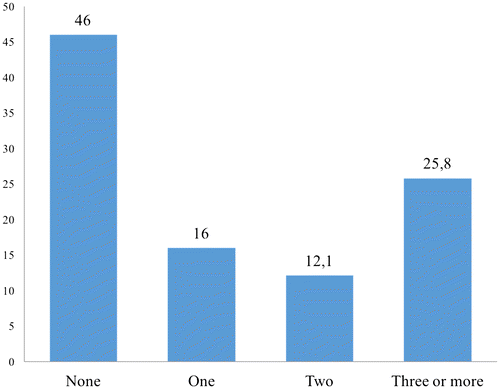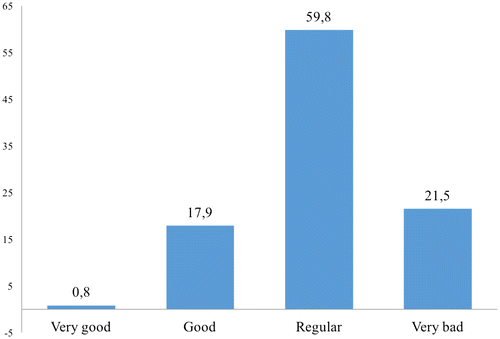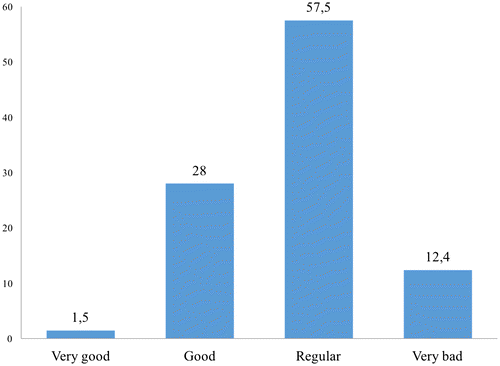 ?Mathematical formulae have been encoded as MathML and are displayed in this HTML version using MathJax in order to improve their display. Uncheck the box to turn MathJax off. This feature requires Javascript. Click on a formula to zoom.
?Mathematical formulae have been encoded as MathML and are displayed in this HTML version using MathJax in order to improve their display. Uncheck the box to turn MathJax off. This feature requires Javascript. Click on a formula to zoom.Abstract
Road safety is a complex process that not only depends on technical and environmental improvements, but in a major part from human factors. In this sense, recent empirical studies have remarked the need to study the interaction between subject and laws, at the glance of several elements preceding road behavior. This is the case of attitudes, opinions and perceptions in the field of road safety, factors that influence the interaction with issues such as traffic rules, police supervision, penalties and justice in traffic. The objective of this study was to describe the self-rated knowledge and perceptions regarding traffic norms and its interaction with road safety among drivers. For this study, a sample of 1,100 Spanish drivers was obtained from a national sampling process. The results showed that the clear majority of drivers consider they know in a sufficient manner the traffic norms, and consider them as effective. Concerning police supervision, almost 70% of them consider that it is effective, but generally assumes that traffic agents prefer to be located in strategical places to catch offenders, rather than in really dangerous places. Regarding sanctions, drivers conceived the punishment to road offenders principally as educational and tax-collection measures. Finally, the general assessment of justice in traffic provided by Spanish drivers has shown a regular-low valuation degree. The obtained results invite to discuss about the interaction between traffic norms and road user, with the aim of promoting a positive law enforcement as a manner to build road safety culture.
Public Interest Statement
Road safety is a complex process, that not only depends on environmental and technical advances. In fact, from 70% to 80% of road accidents and injuries are scientifically considered as derived from human behavior. For this reason, it is important to understand the relationship between road users and traffic norms, supervision, sanction and justice in general. In this study, aimed to describe the knowledge and perceptions of drivers regarding traffic norms and its interaction with road safety, it has been observed that most of drivers affirm to know traffic rules and consider it as effective. However, and regarding police control and traffic fines, drivers tend to assume that the main reasons for this facts are merely economical, or perhaps educative. It becomes relevant to discuss about traffic normative-road user interaction, with the aim of promoting a positive law enforcement among road users, as a manner to improve road safety culture.
1. Introduction
Traffic accidents are a major cause of death and injury around the entire world. According to the World Health Organization (WHO), 1.23 million people worldwide die each year due to traffic accidents (World Health Organization, Citation2015). Note that, despite the recent progressive increasing of population and vehicles, accident rates have been relatively stabilized since 2007, indicating a considerable improvement in terms of road safety practices along the last decades. Nevertheless, accidents on the road are still being the leading cause of death for people between 15 and 29 years (World Health Organization, Citation2015). Setting an example, the Spanish population registered a rate of 45 deaths in traffic accidents per million inhabitants along the year 2011, a fact that have placed Spain slightly below the average of the European Union. Moreover, since 2008, traffic accidents have gone from being the first external cause of death, to be located in the second position (Gómez-Barroso, López-Cuadrado, Llácer, Palmera Suárez, & Fernández-Cuenca, Citation2015). Thus, in several countries statistical reports have been reporting progressively lower rates of casualties in traffic accidents, specially regarding the number of deceased and injured people (Ernstberger et al., Citation2015). These positive changes happened, in part, due to a growing public awareness, and partly, as a mid-term outcome of the measures implemented from public administrations, fact which does not mean –by itself- that traffic accidents are not remaining a serious problem for society. Furthermore, some harmful factors that modulate road behavior, subsequently increasing the risk of traffic crashes and injuries (e.g. stress, fatigue, adverse working conditions, aggressiveness) are still affecting many drivers and other road users worldwide (Alonso, Esteban, Useche, & López de Cózar, Citation2016; Moore & Dahlen, Citation2008; Useche, Gómez, & Cendales, Citation2017).
On the other hand, the exertion of an effective prevention of traffic accidents use to be preceded by, for instance, a proper knowledge of the traffic rules among road users, a sufficient police supervision, sanctions and justice in the field of road safety (Alonso, Esteban, Calatayud, Sanmartín, Alamar, & Ballestar, Citation2015). Specifically regarding legislation on road traffic, it represents an essential aspect that every road user should know and understand, and use to be enforced through road formation or training (at the driving school), mass media and road safety education. However, the external regulation of the behavior of different road users, especially the drivers, is considered as a manner of preserving the life and welfare of the entire community. In other words, it is almost evident that, the risk that drivers assume on the road does not only impacts on their own safety (Cendales, Useche, & Gómez, Citation2014; Gopalakrishnan, Citation2012), but it potentially also may compromise the safety of every road user (Alonso, Esteban, Calatayud, Sanmartín, Alamar, & Ballestar, Citation2015; Fredriksson, Rosén, & Kullgren, Citation2010).
1.1. The role of supervision and punishment on traffic safety
In relation to police supervision, in the specific case of Spain, the monitoring and control systems, measures and countermeasures, have been substantially intensified through the recent years. Given the possible increasing of traffic offenders, especially those performing dangerous behaviors on the road such as driving after consuming alcohol and drugs, or non-using seat belts, it has become imperative to adopt new and more intensive strategies for surveillance and risk prevention (Alonso, Pastor, Montoro, & Esteban, Citation2015). However, it must be mentioned that, in a holistic view, a constant monitoring and coercive measures –including traffic sanctions- are important, but not enough to build a road safety culture, considering that public awareness and norm internalization should be the ultimate objective of all these measures (Valkanova, Jorda, Tomitsch, & Vande Moere, Citation2013). Meanwhile, sanctions are necessary for drivers to perceive the potential consequences of their road misbehaviors, and thus prevent different the occurrence or reoccurrence of different risky behaviors (Vargas, Castro, Martos, & Trujillo, Citation2012). Many of drivers are, nevertheless, still unaware of which type of penalty is associated to each road offense; for example, if its punishing manner corresponds to an economic, administrative or penal/criminal sanction (Alonso, Esteban, Calatayud, Sanmartín, Alamar, & Ballestar, Citation2015; Alonso, Esteban, Serge & Ballestar, Alonso, Esteban, Serge, & Ballestar, Citation2017).
Finally, and leaving behind the mere explanation of why some people use to violate traffic norms through the commission of different misbehaviors on the road, the positive question of why people are willing to comply with the law and to cooperate with the police has also been addressed and developed in recent studies (Shen, Ge, & Qu, Citation2017; Shope, Citation2006). Further, according to the procedural justice model, traffic law compliance is positively influenced by the trustiness in the police, and the control bodies, building the legitimation of institutions that, at the same time, acquire social representations related to respect and obedience (Van Damme & Pauwels, Citation2016). This fact becomes really important when considering that traffic safety policies are still conventionally ranked as financial and environmental issues in many developing countries, yet the concept of equity can be advantageously used as an integral part of the process of traffic safety policy-making. Equity in transportation is, moreover, defined as how appropriately and equally the impacts of transportation are distributed among different types of users (Najaf, Taghi Isaai, Lavasani, & Thil, Citation2016), and aims, at the same time, to represent an enforcer for road safety culture among all road users.
Finally, and despite all merely theoretical factors usually considered when studying law compliance, it should be noted that legal behavior could not be understood in the same manner everywhere, being modulated according to diverse factors such as: cultural differences, supervision or prosecution strategies, the existing norms by themselves, and the social/informal and institutional/formal judgment for its compliance or noncompliance (Alonso, Esteban, Calatayud, Sanmartín, Alamar, & Ballestar, Citation2015).
1.2. Study framework
Law, and all its related aspects, and its interaction with decision-making and psychological processes, have an essential part becoming from legal science. Moreover, law is an issue that applies to all individuals and societies, so it constitutes a permanent focus for social sciences, including sociology and psychology. Individuals and societies may or may not know the laws, they may or may not accept them, they may or may not share their principles, and they may or may not obey them. In this sense, our previous research experiences have shown us that compliance with standards is related to how individuals perceive and interact with them (Alonso, Esteban, Calatayud, Medina, & Alamar, Citation2005). In addition, the law is not the only issue to consider when aiming to explain social behavior: rules or norms make no sense unless there are consequences when they are not obeyed. From this approach, and in this specific field, traffic laws should be treated from a comprehensive perspective.
Moreover, it is important to understand legislation and everything it involves and to regulate drivers’ behavior since reckless behavior not only affects the driver itself but other people (drivers and pedestrians on the road). Therefore, it is preserving one’s life and the life of others. Therefore, the framework of this article was a large-scale project based on “traffic laws and road safety” to raise people’s awareness regarding this matter (Alonso, Esteban, Useche, & Faus, Citation2017; Alonso, Sanmartín, Calatayud, Esteban, Alamar, & Ballestar, Citation2005).
This global research on traffic laws and road safety used a questionnaire composed by a set of items in different sections. An important aspect of the questionnaire is the order of the questions. The objective of the items was not to influence the answers in a particular direction. First of all, the questionnaire was used to collect sociodemographic data (such as age, gender, occupation, etc.). In addition, other descriptive factors relevant to road safety were also considered, in order to classify drivers: main motive of the journey, driving frequency, professional drivers, driving experience, kilometers per year, type of journey, most frequently used type of road, and record of accidents and penalties. There were also subsections disposed to collect information related to these areas: unsafe/risky behaviors (speeding, inappropriate speed in specific situations, unsafe following distance, shouting or verbally insulting while driving, driving under the influence of alcohol, driving without a seat belt, smoking while driving, driving without insurance, driving without the required vehicle inspection). It was also interesting to learn about the beliefs, knowledge, and attitudes of participants towards the areas of “legislation”, “penalties”, “law enforcement”, “law and traffic laws”, and the “effectiveness of the measures to prevent traffic crashes”.
The study described in this article is based on some items of the section “unsafe/risky behaviors”, and the “knowledge, police supervision, sanctions and justice” subsection. In this section of the questionnaire, participants were asked to provide information about these questions: reasons and frequency, risk of behavior, severity of the penalty, estimated probability of penalty, type of penalties, and penalties received (evaluation and effectiveness).
1.3. Objective
The aim of this study was to describe the self-rated knowledge and opinion on issues related to traffic, traffic laws and road safety among Spanish drivers. Specifically, this study focuses on issues relating to traffic rules and regulations, police supervision, sanctions and justice.
2. Materials and methods
2.1. Participants
The sample was obtained through Cluster Random Sampling (CRS), based on the distribution by gender and age of the population belonging to the different Autonomous Communities of Spain. The main criteria for the distribution of the sample was the election of households in proportional samples to the population size of each Autonomous Community. The election of individuals was proportional to the population studied by age group and sex. The survey was aimed specifically for interviewing drivers with driving license, being this (the fact of not being a driver) an exclusion criteria. The proportion of subjects reflects the census, it includes drivers from 14 years to over 65 years. In terms of age (see Table ), it can be clearly seen how the percentage distribution is proportional to the general census of drivers. So, the age group most represented is the group between 30 and 44 years old (38.01%), and people between 14 and 17 years are the less represented.
Table 1. Distribution national census and sample, based on age groups
The full sample size was 1,100 participants, composed by 678 men (61.60%) and 422 women (38.40%), with a margin of error estimated in ±3%, with a confidence interval of 95% in the most unfavorable case of p = q = 50%, and a level of significance established at 0.05. The gender distribution is closely related to age, but in this last case, the proportion of women decreases in older ages (from 45 years), in the same manner that happens in the driving population in Spain.
2.2. Procedure and design
The employed methodology in this study was based in an observational cross-sectional method, in which people was questioned about their views on the traffic norms, sanctions and justice (general functioning of the justice, and of the justice specifically within the field of traffic) in Spain.
The questionnaire includes the knowledge, attitudes and behaviors of users to traffic and road safety. Its comments refer to both “assessment of current traffic rules as assessment of the behavior on the road scenario”. The survey consists of a series of questions structured around a few different sections which address the objectives pursued in the investigation. The questionnaire was applied using a semi-structured telephone interview with a maximum duration of 20 min by staff of EMER-GfK. The staff responsible for conducting the survey countries have followed the instructions of the research team. The average duration of the interview was 20 min, with some variability due to individual differences themselves.
To achieve the aims, the next variables were considered:
| • | Demographic variables: sociodemographic factors such as age and scholar level. | ||||
| • | Opinions on traffic rules: Subsequently, drivers were asked about their opinions on the following questions: “level of knowledge”, “perceived effectiveness” and “qualification of traffic rules and road safety”. | ||||
| • | Perceptions of Police supervision: information was extracted from these variables: “the perception of police oversight by users” and “beliefs about the purpose of this supervision”. | ||||
| • | Questions relatives to traffic sanctions: drivers were asked about their opinions about “perception of the purpose of the sanction”, “the criteria for establishing the type of sanction” and “received sanctions (including parking fines)”. | ||||
| • | Justice opinions: information was extracted from these variables: “the functioning of justice in general in Spain”, “the functioning of justice on traffic and road safety” and “involvement in a traffic lawsuit”. | ||||
As previously mentioned, the survey was composed by a set of blocks of issues relating to traffic and road safety. Focusing on questions about the rules, the first aim of this block was to assess the degree to which the person knows the rules with 4 response options: a lot, quite, little or nothing. The second question block was built to determine (in a scale composed by values from 0 to 10) the perceived effectiveness of traffic rules as a measure to prevent accidents, being 0 “not effective at all” and 10 fully effective. The third question block was designed to assess if respondents perceive rules as fair or unfair, adequate, excessive or sparse, and well done or poorly done.
Regarding questions concerning Police supervision, participants were firstly asked about their opinion on whether the police supervision is, in their view, poor, adequate or excessive. Secondly, they were asked for the degree of agreement with some statements in this regard, may responding in 4 possible agreement degrees: totally agree, quite agree, somewhat agree and strongly disagree. The statements were the following: “agents are placed in certain places just to catch us”, “agents are placed in certain places because that places are more dangerous” and “agents are placed in certain places to stop vehicles with a good level of security”.
For the question block on traffic sanctions, participants were asked to assess if they agree or not (i.e. totally agreeing, quite agree, somewhat agree or not agree) with various aspects that may be considered when sanctioning a road user. These aspects were: how dangerous is the realized misbehavior, the seriousness of the offense and the consequences of the infringement. Secondly, they were asked about the type of sanction that should be applied to offenders causing serious or fatal injuries for traffic accident victims. So, they had to answer whether (or not) they consider pertinent to apply various types of sanctions such as financial penalties, imprisonment, temporary suspension and withdrawal of driving license for that offenders. Thirdly, they were asked about their degree of agreement with the following statements: “the purpose of the sanction is essentially tax collection”, “the purpose of the sanction is primarily educational” and “the purpose of the penalty is fundamentally punitive.” Finally, they were asked about the number of penalties they have received, including and excluding (for analysis purposes) fines for parking.
For the last block of questions, related to the justice system, first they were asked about their views on the functioning of justice in Spain using a scale including the options: very good, good, fair and very bad. Following, this same scale was used to assess their perception on the functioning of justice in Spain in the specific field of traffic and road safety. Finally, drivers were asked about various questions whose answer was “yes” or “no”, such as “have you been involved in a traffic accident?” (in case of an affirmative answer, as witness, defendant or victim), “do you believe it is fair the fact that the professional driver has a different treatment from the regular driver?” and “do you think that specialized courts should be created for cases on traffic and road safety”?
2.3. Statistical analysis
Once the data was obtained, the relevant statistical analyses were carried out using the Statistical Package for the Social Sciences (SPSS), version 23.0. For comparing mean values of continuous study variables, after realizing normality tests and testing basic parameters, One-way Analysis of Variance (ANOVA) test was used, followed by Bonferroni’s Post-hoc test, with the aim of determining potential differences among drivers differenced by specific demographical, individual and/or social characteristics. Statistical significance level was established at p < 0.05.
3. Results
3.1. Traffic rules
In reference to the first set of questions answered by the participants of this study, i.e., the self-rated level of knowledge of traffic rules, the perceived effectiveness of these rules and qualification of traffic rules and road safety, it was found that (Figure ).
Regarding their “knowledge of the traffic norms”, 70.4% of respondents say they know it quite well, while 11% say they know a lot traffic regulations. Meanwhile, there is a minimum but worrying group of people stating that they do not know traffic rules at all (1.1%).
About driver’s perception of traffic rules or norms as a measure to prevent traffic accidents, the mean score was = 7.52 (SD = 1.970) indicating a high percentage of agreement to the statement. Thus, 95% of respondents approve the effectiveness of the rules and 74% of them rate their effectiveness with more than 7 points over 10.
Considering various factors and their relationship to the perception of the effectiveness of the rules, it has been found that there are significant differences regarding whether the person has been involved or not in a traffic accident (F(1, 1112) = 7,580, p < 0.05). So, those who have been involved ( = 7.68; SD = 1.925) have a significantly higher score than people who have not been involved in a traffic crash (
= 7.35; SD = 2.008).
Finally, with regard to the “status of traffic rules,” 87.9% of participants fair valued existing traffic rules: 68.8% value them as adequate, and 86% think that traffic norms are well designed. Complementarily, 12.1% value rules as unfair, 31.4% assess them as inadequate (9.5% by excessiveness, and 21.9% for scarcity), and 13.9% of the sample think that traffic regulations are poorly made. In general, high scores in the three presented statements have been obtained.
Significant differences were also found between the effectiveness attributed to traffic norms and their qualification as fair or unfair (F(1,1048) = 92,599;p < 0.05). Thus, people who consider them fair tend score higher on the effectiveness of traffic normative as a preventive measure ( = 7.83; SD = 1.789). On the other hand, those drivers who consider rules as more unjust or unfair, tend to present a lower score (
= 6.06; SD = 2.36).
3.2. Police supervision
This section examined the perception of police oversight by users, and beliefs about the purpose of this supervision. Regarding the first aspect, 65.9% of drivers considered police supervision as poor, while 5.5% considers it as excessive. Notably, less than a third part of respondents consider police supervision as adequate (28.7%) (Figure ).
There is a notable relationship between the perception of police supervision and qualification of traffic norms, considering that drivers who value this first element as poor, adequate or excessive, also tend to value the second factor in the same manner.
Regarding the appraised purpose of police supervision, a high percentage of respondents are fairly or strongly agreed with the statement “the agents are placed in certain places of the roads to catch offenders” (77%) (Figure ).
Figure 3. Level of according to affirmation “agents are placed in places to stop vehicles security”.
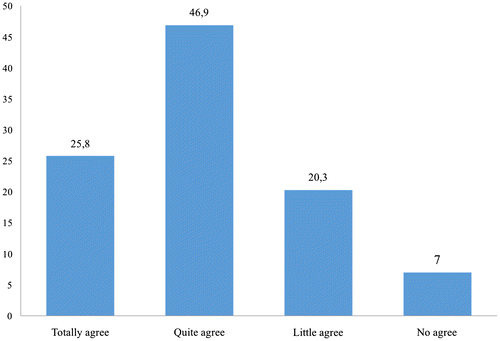
It must be mentioned that, for the case of the statement “the role of agents is to ensure users of the road”, it was observed a very high agreement among respondents (73% are quite or completely on agree). Nevertheless, on the other hand, the degree of disagreement with the statement “the agents are placed in the most dangerous places of the road” was substantially high, since almost half of participants, stated their level of agreement in somewhat (32.6%) or nothing (16.3%) (Figure ).
3.3. Sanctions
For the section/block concerning to traffic sanctions, the issues related to “the perception of the purpose of the sanction”, “the criteria for establishing the type of sanction” and “received sanctions (including parking fines)” were analyzed.
Regarding the “purpose of the sanction,” a high percentage of participants believe that the main function of traffic fines is the tax collection (almost 50%). Only 14% of Spanish drivers were in total disagreement with that statement (Figures and ).
As for question if drivers consider that there is an educational function in traffic penalties, this dichotomous (Yes/No) question was affirmatively agreed by 63.3% of respondents, being only the 12.3% of respondents the ones that shown their total disagreement with the proposed statement.
As an interesting fact, those people who show a greater knowledge of the traffic rules, also tend to believe that the penalty is more educational, and not primarily a tax-collecting measure. However, 35.8% of participants self-reporting a high knowledge of traffic norms also consider that the main function of traffic fines is reduced to merely punish road users.
On the other hand, the analysis of the criteria to stablish the type of sanction according to each road misbehavior shows that participants believe that it should be principally based on the dangerousness, the severity and the consequences of risky road behaviors (Figure ).
Regarding received sanctions along the last years, with the exception of the penalties for parking, 44% of drivers declared they have received one or more traffic sanctions. Only 56% reported no traffic fines. On the other hand, 46% said they had not received any penalty for parking, and it is noteworthy that 25.8% affirm they have received more than 3 penalties for parking (Figures and ).
It should be highlighted the set significant differences in received sanctions of the group that normally drive using urban roads, with respect to those who use to travel by conventional highways (except fines for parking). In general, participants belonging to the first group have not received any sanction, but the latter have received, in average, two or more sanctions. Also, it is the people with a higher yearly mileage who, at the same time, have received more penalties (including for parking).
It is also relevant to mention that 70% of drivers who have not received any sanction for parking believe, at the same time, that policing in the field of traffic is considerably poor, and 55.7% of those who think that the Police supervision is excessive have, in general, received two or more sanctions parking.
3.4. Justice
For this final section of the questionnaire, the opinion on “the functioning of justice in general in Spain,” “the functioning of justice and traffic and road safety” and the “involvement in a lawsuit traffic” were assessed.
Regarding the functioning of justice in Spain, only 0.8% of respondents considered it very good. Moreover, more than 75% consider that the operation of the justice system is slightly bad or very bad.
In reference to the perception of the justice in the specific field of traffic and road safety, the results are slightly better than in the previous case, but still being not high. Thus, 57.5% of Spanish drivers believe that justice in that area is slightly bad and 12.4% considers that as very bad. On the other hand, only 30% of participants valued its functioning as good or very good (Figures and ).
Finally, specifically analyzing if participant drivers have been involved at a trial for reasons of traffic, it was found that 16.8% of them have attended to a trial of traffic, and 83.2% had not been involved in this type of event. Particularly, within respondents who have been involved at a trial of this type, 43.9% have been involved as victims, 29.4% as defendants, and 26.7% as witnesses.
4. Discussion
In this study, we have analyzed several variables and relevant facts, reaching some clear tendencies and perceptions of Spanish drivers regarding their interaction with law, norms, punishment and justice inside and outside the field of traffic safety. In brief, with respect to existing regulations, there is a large percentage of participants who consider having a fair knowledge of traffic normative (70.4%). Although it constitutes a positive fact, but it should be, also, contrasted with objective (not only self-reported) knowledge among respondents, as well with non-registered rates of traffic, considering that traffic fines punish only a minor part of all misbehaviors occurring on the road.
For instance, contrasting to other studies where the level of knowledge about traffic rules and behaviors on the roads were objectively assessed, it is possible to state that the declared and objectively-appraised normative knowledge and behavior on the road may be substantially different (Martínez Beltrán, Citation2013). In this sense, the evidence has shown that traffic accidents are generally caused by the recklessness of drivers and their disregard for traffic norms (Bates, Davey, Watson, King, & Armstrong, Citation2014), and even, several traffic accidents may be prevented improving and monitoring different behaviors of road users (Hakkert, Gitelman, Cohen, Doveh, & Umansky, Citation2001; Wouters & Bos, Citation2000).
Moreover, empirical studies have suggested that the performing of traffic violations based on risky behaviors have different trends among drivers, according to variables such as gender, age and driving experience (Oviedo-Trespalacios & Scott-Parker, Citation2017). In fact, gender and age have shown to exert a significant influence on attitudes towards the commission of traffic violations and normative infractions (Awialie Akaateba & Amoh-Gyimah, Citation2013; Useche, Citation2011). In the specific case of young drivers, who constitute a highly vulnerable group in terms of traffic accidents (Scott-Parker & Oviedo-Trespalacios, Citation2017), traffic law-compliance suggests to be more related with a perceived sense of obligation to accomplish traffic laws and perceived fairness of punishment. On the other hand, driving violations among older drivers are more explained predicted by the instrumental motive of perceived danger of violations (Useche, Serge, & Alonso, Citation2015; Yagil, Citation1998). In regard to the several risky factors related to norm compliance for the case of young drivers, the informative and educational process might part both from the road safety education received from scholar system (Alonso, Esteban, Useche, & Manso, Citation2016), both as the licensing process or an improved road training/formation process, learning to identify and managing potential risk factors that are related, besides normative accomplishment, to driving safety and the avoiding of negative outcomes in terms of accidents and injuries (Voas & Kelley-Baker, Citation2008).
In relation to the perception of police supervision, 65.9% of drivers considered its level as considerably low, while only 28.7% think it is appropriate. As for the place where agents use to be positioned on the roads, most of participants think they choose strategic places to catch drivers, as well as, in a second place, to manage and ensure the safety of road users. In contrast, respondents did not consider, in a substantial manner, that control radars and checkpoints were located in the most dangerous places. About this issue, there is a clear lack of scientific literature, reason for which it would be interesting to conduct more studies in this field. In this regard, some empirical experiences have related the effectiveness of social norms applied to the field of traffic with a major mass-media exposition of road users on campaigns and informative actions, directed to create awareness and preventing the occurrence of road misbehaviors, instead reducing the law compliance to the mere perception of a potential punishment (Perkins, Linkenbach, Lewis, & Neighbors, Citation2010). Furthermore, technological advances may explain a major engagement to the useful information to enhance interaction and adherence to social norms, and prevent road crashes based on the human factor, considering that risk perception and agreement with norms constitute relevant predictors of distracted and risky driving (Carter, Bingham, Zakrajsek, Shope, & Sayer, Citation2014; Gauld, Lewis, White, & Watson, Citation2016; Oviedo-Trespalacios, Haque, King, & Washington, Citation2017a).
Regarding registered penalties among surveyed drivers (i.e. traffic fines), most of them believe that the role of sanctions is the education of road users (58.8%), tax collection (63.3%), and chastening (73%). Meanwhile, regarding the criteria for establishing the sanction, drivers highlight the danger represented by the misbehavior, the seriousness of the offense, and the consequences it has entailed. Thus, in this research it has been highlighted as essential fact cause behavioral changes and behavior through road safety education and communication campaigns on road health (Alonso, Esteban, Useche, & Manso, Citation2016), evidence-based professional interventions (Useche, Citation2012), incentives (taxes and exemptions) and dissuasion (punishment for risky behavior) also through legislation seeking the design requirement of safer products (indirect technical safety standards and regulations) or amending the information flow available for road users (e.g. advertising restrictions and infrastructural issues) (Málaga, Citation2010; Oviedo-Trespalacios, Haque, King, & Washington, Citation2017b).
Finally, in relation to justice, and specifically traffic to justice, there is a large number of Spanish drivers who value its functioning as “slightly bad” or simply “bad”, something that certainly needs to be improved. However, this statement is based in a relatively short proportion (16.8%) of the participants in this study, who have participated in some way in a trial related to a traffic event.
5. Conclusions
Traffic norms accompany road users along their entire lifecycle, and use to modulate their behavior in most of their interactions with others. In other words, rules and normativity not only limit the possibilities of action of people, but also help to preserve the rights and welfare of the community, i.e., the public health. Road safety regulations allow the correct interaction of all users, despite their role on the road: pedestrians, drivers and cyclists. It is therefore necessary that all individual have enough information and are aware of these regulations, strengthen by agencies certifying that such legislation is enforced or, in the proper case, applied in a punishing manner that should be viewed by road users in a more educational manner, instead to be perceived by a significant proportion of drivers as a merely tax collection mechanism.
In short, this research reflects a non-despicable negative status on the perception of traffic normative among Spanish drivers, and the need of incentivizing institutions to teach, and users to properly learn traffic norms and law-complying behaviors, especially those currently that are more infringed and related to road traffic crashes, as a manner for strenghten road safety.
6. Limitations and future research
One of the most important limitations of this work is related with the use of self-report as primary source of information, explaining potential several biasing sources, such as social desirability, acquiescence or an inefficient understanding of the questions (Perinelli & Gremigni, Citation2016). In this regard, and as a recommendation for future research experiences, it is important to remark the using of observational methods and/or external data sources for the supplementary assessment of self-rated perceptions and behaviors, whose greatest asset could be, in this case, the minimizing of the “common method biases” often affecting cross-sectional designs (Podsakoff, MacKenzie, Lee, & Podsakoff, Citation2003).
Regarding the study of issues related to the knowledge of traffic normative, it would be very useful to contrast the objective awareness of traffic rules (self-rated) with supplementary questions on which traffic norms are (apart of well-known) perceived as more violated by drivers and perceived as more punished by traffic authorities. This information would be very advantageous to identify risk factors and attitudes among (for instance) young drivers and other road users with a higher predisposition or vulnerability to commit risky behaviors and suffer accidents.
Finally, and towards achieving broader goals from the point of view of contents and methodology employed for developing of further studies in the field, it is suggestible to focus also on studying the discursive face of attitudes regarding laws, the importance of its knowledge, understanding and accomplishing, as a manner to deeper understand the view of drivers and other road users.
Funding
The authors received no direct funding for this research.
Additional information
Notes on contributors
Francisco Alonso
Francisco Alonso, Psychologist and PhD from the University of Valencia (Spain). Master in Communication and Master in Strategic Consulting. Associate professor (Faculty of Psychology). Expert in Traffic and Road Safety. Director of the INTRAS (Research Institute on Traffic and Road Safety), an interdisciplinary research Centre of the University of Valencia.
Cristina Esteban
Cristina Esteban, Psychologist and PhD from the University of Valencia (Spain). Associate professor (Faculty of Psychology). Expert in Traffic, Road Safety and Road Education. Member of the Development and Advising in Traffic Safety (DATS) group (INTRAS).
Luis Montoro
Luis Montoro, Psychologist and PhD from the University of Valencia (Spain). Full professor (Faculty of Psychology). Expert in Traffic and Road Safety. Director of the Human Factor and Road Safety (FACTHUM.lab) group (INTRAS).
Sergio A. Useche
Sergio A. Useche, Psychologist and MA in Psychology from the University of Los Andes, in Bogotá (Colombia). Doctoral Student and researcher at the University of Valencia, Spain. Consultant in Work Health and Road Safety. Member of DATS group (INTRAS).
References
- Alonso, F., Esteban, C., Calatayud, C., Medina, J. E., & Alamar, B. (2005). La Justicia en el Tráfico. Análisis del ciclo legislativo-ejecutivo a nivel internacional. Barcelona: Cuadernos de Reflexión Attitudes, Attitudes.
- Alonso, F., Esteban, C., Serge, A., & Ballestar, M. L. (2017). Shouting and cursing while driving: Frequency, reasons, perceived risk and punishment. Journal of Sociology and Anthropology, 1(1), 1–7. doi:10.12691/jsa-1-1-1
- Alonso, F., Esteban, C., Useche, S. A., & Faus, M. (2017). Smoking while driving: Frequency, motives, perceived risk and punishment. World Journal of Preventive Medicine, 5(1), 1–9. Retrieved from http://pubs.sciepub.com/jpm/5/1/1
- Alonso, F., Esteban, C., Useche, S. A., & López de Cózar, E. (2016). Prevalence of physical and mental fatigue symptoms on Spanish drivers and its incidence on driving safety. Advances in Psychology and Neuroscience., 1(2), 10–18. doi:10.11648/j.apn.20160102.12
- Alonso, F., Esteban, C., Useche, S. A., & Manso, V. (2016). Analysis of the state and development of road safety education in Spanish higher education institutions. Higher Education Research, 1(2), 10–18.
- Alonso, F., Pastor, J. C., Montoro, L., & Esteban, C. (2015). Driving under the influence of alcohol: Frequency, reasons, perceived risk and punishment. Substance Abuse Treatment, Prevention, and Policy, 10, 11. doi:10.1186/s13011-015-0007-4.
- Alonso, F., Sanmartín, J., Calatayud, C., Esteban, C., Alamar, B., & Ballestar, M. L. (2005). La justicia en el Tráfico. Conocimiento y valoración de la población. Barcelona: Cuadernos de Reflexión Attitudes, Attitudes.
- Awialie Akaateba, M. A., & Amoh-Gyimah, R. (2013). Driver attitude towards traffic safety violations and risk taking behavior in Kumasi: The gender and age dimension. International Journal for Traffic and Transport Engineering, 3(4), 479–494. doi:10.7708/ijtte.2013.3(4).10
- Bates, L. J., Davey, J., Watson, B., King, M. J., & Armstrong, K. (2014). Factors contributing to crashes among young drivers. Sultan Qaboos University Medical Journal, 14(3), e297–e305.
- Carter, P. M., Bingham, C. R., Zakrajsek, J. S., Shope, J. T., & Sayer, T. B. (2014). Social norms and risk perception: Predictors of distracted driving behavior among novice adolescent drivers. Journal of Adolescent Health, 54(5), S32–S41. doi:10.1016/j.jadohealth.2014.01.008
- Cendales, B., Useche, S. A., & Gómez, V. (2014). Psychosocial work factors, blood pressure and psychological strain in male bus operators. Industrial Health, 52(4), 279–288. doi:10.2486/indhealth.2013-0156
- Ernstberger, A., Joeris, A., Daigl, M., Kiss, M., Angerpointner, K., Nerlich, M., & Schmucker, U. (2015). Decrease of morbidity in road traffic accidents in a high income country—An analysis of 24,405 accidents in a 21 year period. Injury, 46(Suppl 4), S135–S143. doi:10.1016/S0020-1383(15)30033-4
- Fredriksson, R., Rosén, E., & Kullgren, A. (2010). Priorities of pedestrian protection – A real-life study of severe injuries and car sources. Accident Analysis & Prevention, 42(6), 1672–1681. doi:10.1016/j.aap.2010.04.006
- Gauld, C. S., Lewis, I. M., White, K. M., & Watson, B. (2016). Key beliefs influencing young drivers’ engagement with social interactive technology on their smartphones: A qualitative study. Traffic Injury Prevention, 17(2), 128–133. doi:10.1080/15389588.2015.1047014
- Gómez-Barroso, D., López-Cuadrado, T., Llácer, A., Palmera Suárez, R., & Fernández-Cuenca, R. (2015). Análisis espacial de los accidentes de tráfico con víctimas mortales en carretera en España, 2008–2011. Gaceta Sanitaria, 29(S1), 24–29.10.1016/j.gaceta.2015.02.009
- Gopalakrishnan, S. (2012). A public health perspective of road traffic accidents. Journal of Family Medicine and Primary Care, 1(2), 144–150. doi:10.4103/2249-4863.104987
- Hakkert, A. S., Gitelman, V., Cohen, A., Doveh, E., & Umansky, T. (2001). The evaluation of effects on driver behavior and accidents of concentrated general enforcement on interurban roads in Israel. Accident Analysis & Prevention, 33(1), 43–63.10.1016/S0001-4575(00)00014-2
- Málaga, H. (2010). Medidas y estrategias para la prevención y control de los accidentes de tránsito: Experiencia peruana por niveles de prevención. Revista Peruana de Medicina Experimental y Salud Pública, 27(2), 231–236.10.1590/S1726-46342010000200011
- Martínez Beltrán, D. C. (2013). Influencia de los centros de enseñanza automovilísticos en el conocimiento de los conductores en las vías en cuanto a normalización (tesis de grado). Colombia: Escuela colombiana de Ingeniería Julio Garavito.
- Moore, M., & Dahlen, E. R. (2008). Forgiveness and consideration of future consequences in aggressive driving. Accident Analysis and Prevention, 40(5), 1661–1666. doi:10.1016/j.aap.2008.05.007
- Najaf, P., Taghi Isaai, M., Lavasani, M., & Thil, J. C. (2016). Evaluating traffic safety policies for developing countries based on equity considerations. Journal of Transportation Safety & Security. doi:10.1080/19439962.2016.1230163
- Oviedo-Trespalacios, O., Haque, M. M., King, M., & Washington, S. (2017). Self-regulation of driving speed among distracted drivers: An application of driver behavioral adaptation theory. Traffic Injury Prevention, 18(6), 599–605. doi:10.1080/15389588.2017.1278628
- Oviedo-Trespalacios, O., Haque, M. M., King, M., & Washington, S. (2017). Effects of road infrastructure and traffic complexity in speed adaptation behaviour of distracted drivers. Accident Analysis & Prevention, 101, 67–77. doi:10.1016/j.aap.2017.01.018
- Oviedo-Trespalacios, O., & Scott-Parker, B. (2017). The sex disparity in risky driving: A survey of Colombian young drivers. Traffic Injury Prevention. doi:10.1080/15389588.2017.1333606
- Perinelli, E., & Gremigni, P. (2016). Use of social desirability scales in clinical psychology: A systematic review. Journal of Clinical Psychology, 72(6), 534–551. doi:10.1002/jclp.22284
- Perkins, H. W., Linkenbach, J. W., Lewis, M. A., & Neighbors, C. (2010). Effectiveness of social norms media marketing in reducing drinking and driving: A statewide campaign. Addictive Behaviors, 35(10), 866–874. doi:10.1016/j.addbeh.2010.05.004
- Podsakoff, P. M., MacKenzie, S. B., Lee, J. Y., & Podsakoff, N. P. (2003). Common method biases in behavioral research: A critical review of the literature and recommended remedies. Journal of Applied Psychology, 88(5), 879–903. doi:10.1037/0021-9010.88.5.879
- Scott-Parker, B., & Oviedo-Trespalacios, O. (2017). Young driver risky behaviour and predictors of crash risk in Australia, New Zealand and Colombia: Same but different? Accident Analysis & Prevention, 99, 30–38. doi:10.1016/j.aap.2016.11.001
- Shen, B., Ge, Y., & Qu, W. (2017). The relationship between personalities and positive driving behavior in China. PLoS One.
- Shope, J. T. (2006). Influences on youthful driving behavior and their potential for guiding interventions to reduce crashes. Injury Prevention, 12(Suppl 1), i9–i14. doi:10.1136/ip.2006.011874
- Useche, S. (2011). Análisis de errores y violaciones de tránsito en los conductores de Bogotá a través del DBQ (Driving Behavior Questionnaire) [Errors and traffic violations analysis in Bogota City drivers measured by DBQ (Driving Behaviour Questionnaire)]. Revista de Psicología Jurídica, 1(1), 29–37.
- Useche, S. A. (2012). ¿Cómo evaluar e intervenir sobre la conducta antisocial desde la psicología jurídica? Acta Colombiana de Psicología, 15(2), 149–152.
- Useche, S., Gómez, B., & Cendales, V. (2017). Work stress, fatigue and Risk Behaviors at the Wheel: Data to assess the association between psychosocial work factors and risky driving on Bus Rapid Transit drivers. Data in Brief. doi:10.1016/j.dib.2017.09.032
- Useche, S., Serge, A., & Alonso, F. (2015). Risky behaviors and stress indicators between novice and experienced drivers. American Journal of Applied Psychology, 3(1), 11–14. doi:10.12691/ajap-3-1-3.
- Valkanova, N., Jorda, S., Tomitsch, M., & Vande Moere, A. (2013). Reveal-it!: The impact of a social visualization projection on public awareness and discourse. CHI: Changing Perspectives, 3461–3470.
- Van Damme, A., & Pauwels, L. (2016). Why are young adults willing to cooperate with the police and comply with traffic laws? Examining the role of attitudes toward the police and law, perceived deterrence and personal morality. International Journal of Law, Crime and Justice, 46, 103–116.10.1016/j.ijlcj.2016.04.002
- Vargas, C., Castro, C., Martos, F. J., & Trujillo, H. M. (2012). Conocimiento de las normas de tráfico en función de la edad y de la importancia para la seguridad vial. Universitas Psychologica, 11(4), 1277–1289.
- Voas, R., & Kelley-Baker, T. (2008). Licensing teenagers: Nontraffic risks and benefits in the transition to driving status. Traffic Injury Prevention, 9(2), 89–97. doi:10.1080/15389580701813297
- World Health Organization. (2015). Global status report on road safety. Geneva: OMS.
- Wouters, P. I. J., & Bos, J. M. (2000). Traffic accident reduction by monitoring driver behaviour with in-car data recorders. Accident Analysis & Prevention, 32(5), 643–650.10.1016/S0001-4575(99)00095-0
- Yagil, D. (1998). Instrumental and normative motives for compliance with traffic laws among young and older drivers. Accident Analysis and Prevention, 30(4), 417–424.10.1016/S0001-4575(98)00003-7

